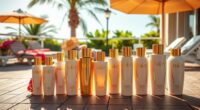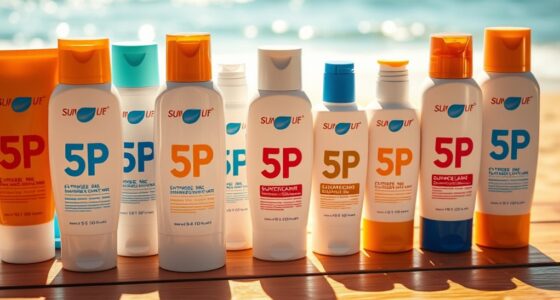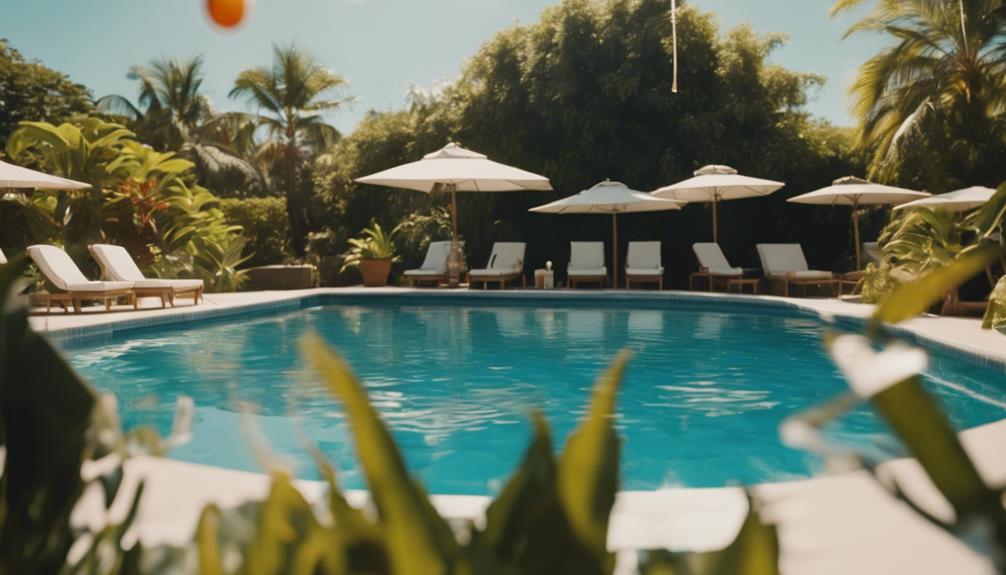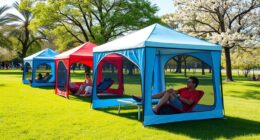Balancing tanning and skin health means understanding how UV exposure stimulates melanin but also causes cellular damage, aging, and cancer risks. While a natural tan is your skin’s way of protecting itself, excessive UV from the sun or indoor tanning beds can harm your DNA and accelerate aging. To keep your skin safe yet get enough vitamin D, use protective clothing, sunscreen, and limit exposure during peak hours. Keep exploring to learn how to care for your skin wisely.
Key Takeaways
- Moderate sun exposure supports vitamin D synthesis while minimizing skin cancer risk through protective measures.
- Avoid indoor tanning devices, as they significantly increase melanoma and skin damage risk.
- Use broad-spectrum sunscreen, protective clothing, and seek shade during peak sunlight hours to safeguard skin health.
- Regularly monitor skin for new or changing moles and lesions to detect early signs of skin cancer.
- Balance sun exposure with skin care routines and lifestyle choices to maintain skin health and prevent premature aging.
Understanding How Skin Tans and What It Means
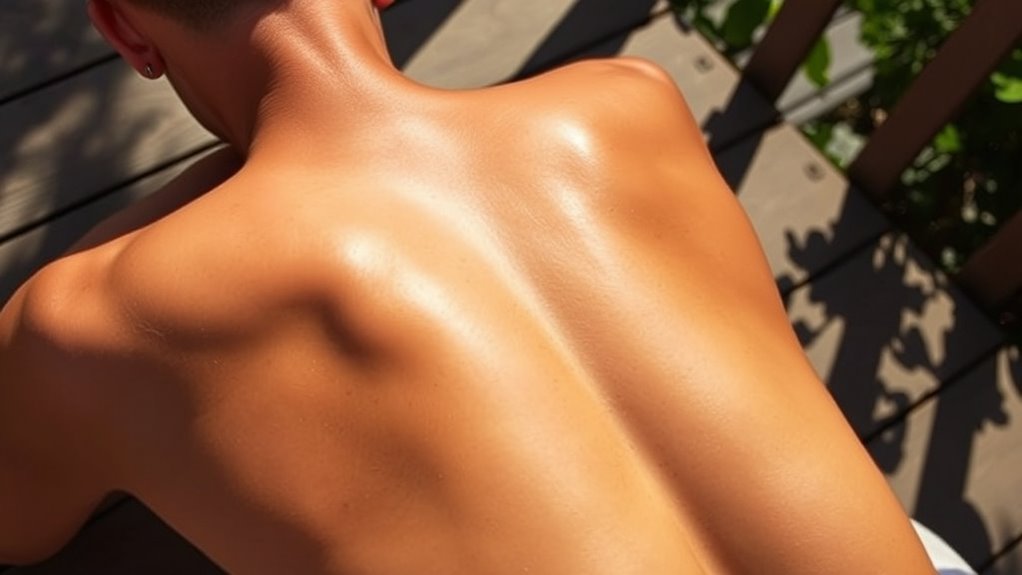
Understanding how skin tans is key to recognizing what a tan really signifies about your skin’s response to sunlight. When exposed to UV rays, your skin produces melanin, the pigment responsible for tanning. Melanin acts as a natural sunscreen by absorbing harmful UV radiation, protecting your skin’s deeper layers. Tanning is a defense mechanism, increasing melanin production to block UV damage. During UV exposure, melanin synthesis rises but only up to a limit; prolonged exposure doesn’t boost melanin further and causes damage like sunburn. Your skin needs rest between exposures to regenerate melanocytes and produce more melanin. The process involves immediate darkening from UVA light and delayed tanning from new melanin synthesis, both reflecting your skin’s effort to shield itself from UV harm. Fokos explains how different types of cookies can influence your browsing and understanding of skin health topics. Additionally, understanding photo-protection strategies can help minimize skin damage while enjoying sunlight.
The Hidden Risks of Indoor Tanning Devices

Indoor tanning devices pose significant health risks that often go unnoticed. The World Health Organization classifies them as carcinogens, putting them on the same level as tobacco and asbestos. The U.S. FDA also warns that these devices increase your risk of skin cancer, including melanoma, which is especially dangerous when tanning begins before age 35. UV rays from tanning beds include UVA and UVB, with UVA penetrating deeply and accelerating aging and cancer development. Tanning beds emit UV radiation comparable to or stronger than natural sunlight, leading to cumulative DNA damage over time. This damage raises your risk for skin cancers like squamous cell, basal cell, and melanoma. Even sporadic use adds up, making indoor tanning a serious hidden threat to your long-term health. Additionally, the potential for cybersecurity vulnerabilities in the operation and monitoring of tanning devices underscores the importance of regulatory oversight and secure technology practices. As security concerns grow, the integration of smart security systems into health devices highlights the need for robust cybersecurity measures to protect user data and device integrity. Recognizing the importance of local legal resources can help individuals better understand their rights and options if issues arise with tanning facilities or devices.
How UV Rays Damage Your Skin at the Cellular Level
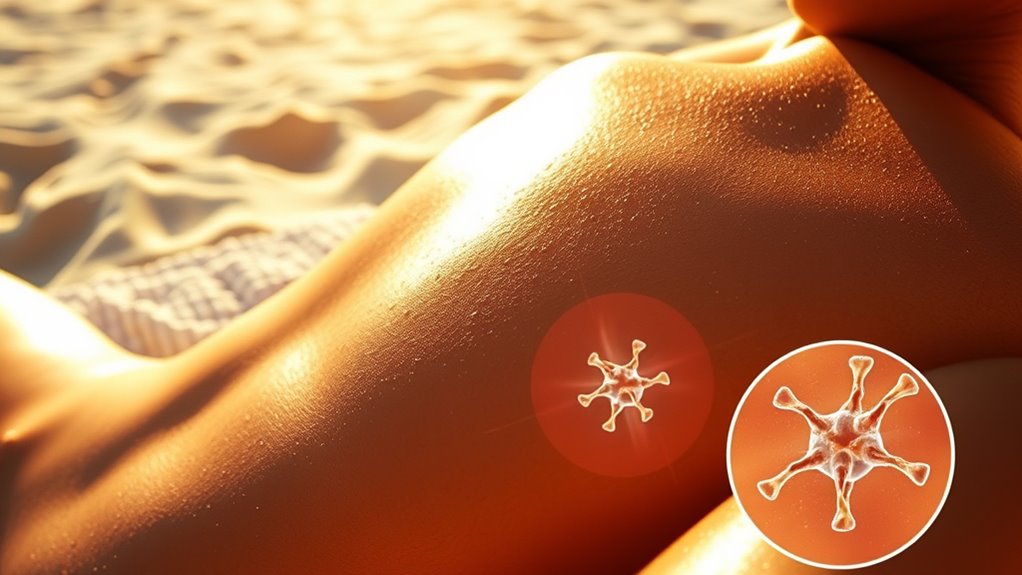
UV rays penetrate your skin and cause direct damage to the DNA within your skin cells, leading to genetic mutations that can trigger skin cancer. UVB causes more direct DNA lesions, like cyclobutane pyrimidine dimers (CPDs), which distort the DNA helix and block replication. Your skin’s repair mechanisms, mainly nucleotide excision repair, work to fix this damage, but defects here increase cancer risk. UV exposure also activates damage response pathways, including p53, which halts the cell cycle, promotes repair, or induces cell death if damage is severe. Excessive UV causes keratinocyte apoptosis and inflammation, leading to sunburn. UVA penetrates deeper, damaging collagen and elastin, accelerating skin aging. Damage to RNA and cellular responses further influence skin health, highlighting how UV rays impact your skin at the cellular level. Understanding DNA repair mechanisms can help in developing better protective strategies against UV damage. Additionally, ongoing research into cellular response pathways provides insights into how your skin defends itself and how these processes might be enhanced to prevent damage. Exploring antioxidant defenses also plays a crucial role in mitigating UV-induced oxidative stress in skin cells. Advances in skin cellular immunity are shedding light on how immune responses can be bolstered to reduce UV-related skin damage. Furthermore, exploring environmental factors can help develop comprehensive approaches to skin protection and health.
The Long-Term Effects of Repeated UV Exposure

Repeated exposure to ultraviolet rays doesn’t just cause immediate skin reactions like sunburn; it also leads to significant long-term health effects. Over time, UV radiation damages your DNA, increasing your risk of skin cancers such as basal cell carcinoma, squamous cell carcinoma, and melanoma—especially if you’ve had severe sunburns early in life. Chronic UV exposure also accelerates skin aging, causing wrinkles, sagging, and liver spots, while making your skin more prone to bruising and slow healing. Your eyes aren’t spared; UV rays can cause cataracts, pterygium, and accelerate age-related macular degeneration. Additionally, UV weakens your immune system, reducing infection defenses and triggering herpes outbreaks. Cumulative UV exposure also increases skin pigmentation, leading to uneven tone and hyperpigmentation, signaling ongoing damage. Protecting your skin from UV damage is crucial for overall health and can help prevent the development of skin cancers and premature aging. Regularly wearing protective clothing and using broad-spectrum sunscreens can significantly mitigate these risks, especially when combined with other photoprotection strategies. Furthermore, understanding long-term effects can motivate better sun safety habits to preserve your skin and eye health over time.
Balancing Vitamin D Needs and Skin Safety
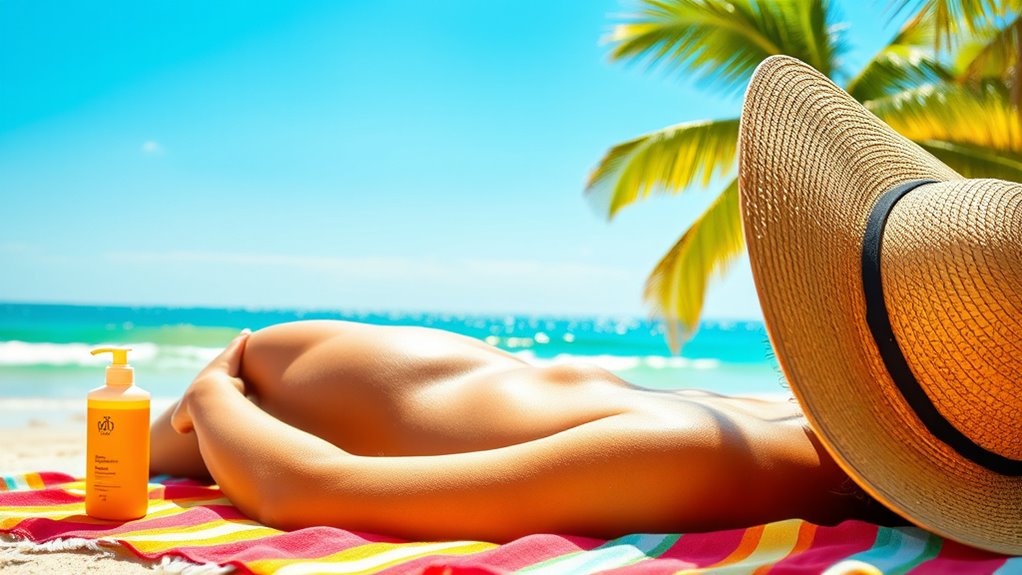
Balancing your need for vitamin D with skin safety requires careful consideration of sun exposure. UVB rays from sunlight help your skin produce vitamin D, but the amount needed varies based on season, location, skin type, and existing levels. Too much sun won’t boost vitamin D further and increases skin cancer risk. Short, regular exposures to small skin areas can support vitamin D synthesis without overexposure. Remember, your body processes only a limited amount of vitamin D at a time, so prolonged sunbathing isn’t beneficial. Sunlight exposure should be moderated to prevent skin damage while maintaining vitamin D levels. If natural sunlight isn’t enough or is risky, dietary sources and supplements can help maintain healthy vitamin D levels. Monitoring your vitamin D status through blood tests is important to avoid deficiency or toxicity. Additionally, understanding the caffeine content in espresso can be useful when considering your overall health and wellness routines. Regular skin checks and awareness of UV exposure risks can further protect your skin. Being aware of the potential security vulnerabilities in new technologies can also help you make safer choices when adopting health-related innovations. Clear guidelines for user consent management help ensure your privacy preferences are respected. Striking this balance ensures your skin remains protected while supporting your overall health.
Protective Measures to Safeguard Your Skin
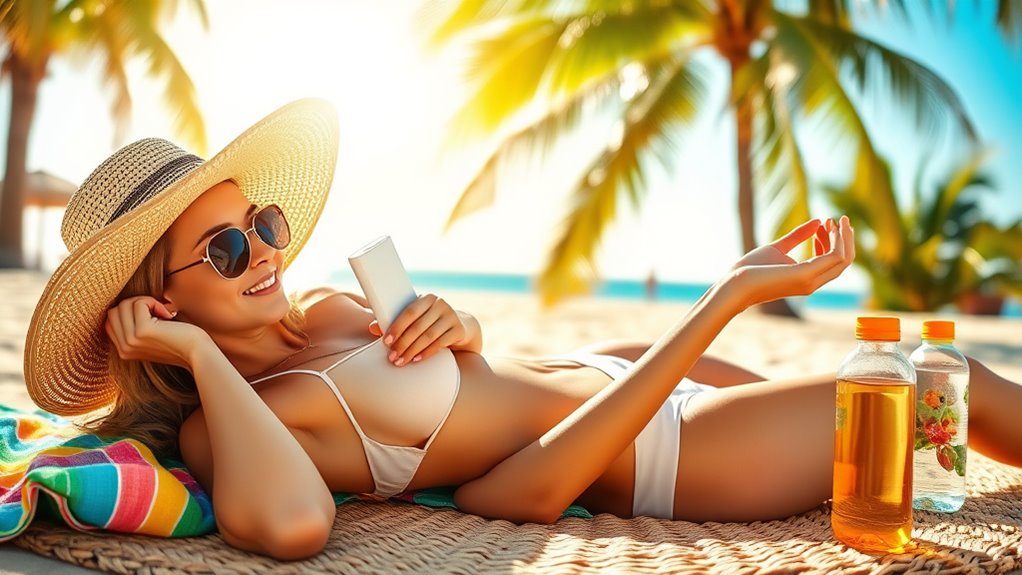
Protecting your skin from harmful rays involves a combination of clothing choices, physical barriers, and behavior adjustments. Wear long-sleeved shirts, long pants, and wide-brimmed hats to shield your arms, legs, face, ears, and neck from UV rays. UV-blocking sunglasses with wraparound designs help protect your eyes and surrounding skin. Choose clothing with UPF ratings for added defense during peak sunlight hours (10 a.m. to 4 p.m.). Use broad-spectrum sunscreens with at least SPF 30, applying generously 15 minutes before exposure and reapplying every two hours or after swimming or sweating. Seek shade, plan outdoor activities earlier or later in the day, and avoid reflective surfaces like water and sand. Incorporating personalized protective strategies can further enhance your skin safety by aligning your habits with your unique skin type and lifestyle, significantly reducing your risk of skin damage and long-term health issues. Utilizing innovative sun protection products such as clothing with UV-blocking properties can also provide an extra layer of defense. Being mindful of natural elements such as water and sand, which reflect UV rays, can also help you optimize your sun protection efforts. For example, eye patch benefits such as protecting the delicate skin around your eyes and reducing puffiness can be an effective part of your overall skin care routine. Additionally, understanding your Mental Wellbeing Index can help you maintain a balanced approach to health and self-care, ensuring that your skin health efforts are part of a holistic wellness routine.
Recognizing Changes and When to Seek Medical Advice

Recognizing changes in your skin after tanning is essential because UV damage can occur even when you don’t notice immediate effects. Tanning causes DNA damage and increases the risk of skin cancer, and a tan doesn’t mean your skin is healthy. Watch for new or changing moles, especially those with irregular borders or asymmetry. Bleeding, itching, or non-healing lesions might signal skin cancer. Discolored or multi-colored patches could indicate melanoma risk. Persistent redness or inflammation beyond a typical sunburn suggests underlying damage. If moles change in size, shape, or color over weeks, or if growths bleed or become painful, seek medical advice. Regular self-examinations and professional skin checks help catch issues early, improving your chances of effective treatment. Understanding the importance of skin health can motivate proactive care and timely intervention.
Making Informed Choices for Healthy Skin
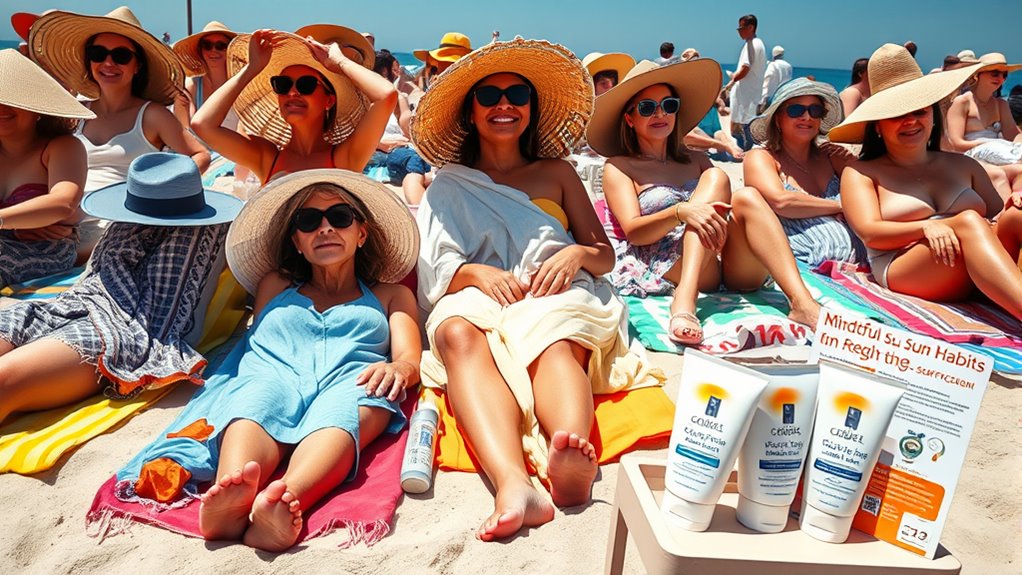
Understanding your skin’s unique needs helps you make better choices to keep it healthy. Knowing your skin type—whether normal, dry, oily, or combination—guides your cleansing and moisturizing routines, preventing irritation and maintaining a strong skin barrier. Eating a diet rich in antioxidants, fruits, vegetables, omega-3 fatty acids, and staying well-hydrated supports your skin’s natural defenses and elasticity. Protect your skin from UV damage by applying broad-spectrum sunscreen daily, wearing protective clothing, and avoiding peak sun hours. Incorporate healthy lifestyle habits like regular exercise, enough sleep, and stress management. Avoid smoking and harsh products that can harm your skin. Consulting professionals for personalized advice and early intervention helps prevent issues and preserves your skin’s health for the long term.
Frequently Asked Questions
Can Tanning Beds Be Completely Safe With Protective Measures?
You ask if tanning beds can be completely safe with protective measures. Unfortunately, no. Even with goggles, limited session times, and skin coverage, the UV radiation from tanning beds still poses risks. Protective gear can’t block all harmful rays, and overexposure can cause skin aging, DNA damage, and eye injuries. Health authorities advise against using tanning beds entirely, as safety can’t be guaranteed, despite precautions.
How Does Skin Type Influence Tanning Risks and Damage?
Did you know that all skin types, even those that tan easily, carry skin cancer risks? Your skin type influences how your skin responds to UV exposure and how much damage it sustains. Lighter skin burns more quickly, but darker skin isn’t risk-free; it can hide early signs of cancer. Protect yourself with sunscreen and sun-safe habits, regardless of your skin tone, to reduce damage and health risks.
Are There Natural Alternatives to Tanning for Cosmetic Appearance?
You can select natural alternatives like self-tanning products made with dihydroxyacetone (DHA), which create a bronzed look without UV exposure. Choose formulas with botanical oils like shea butter and aloe vera to hydrate and promote skin glow. Proper application and exfoliation guarantee even, natural results. These options avoid skin damage, offering a safe, convenient way to achieve a sun-kissed appearance without the risks associated with traditional tanning.
What Role Do Genetics Play in Individual Skin Cancer Risk?
Imagine a hidden blueprint influencing your skin’s story. Genetics play a subtle but powerful role, shaping your risk for skin cancer. If you have a family history or carry certain gene mutations like *CDKN2A*, you’re naturally more vulnerable. While environmental factors like UV exposure matter, knowing your genetic makeup helps you take proactive steps. Regular check-ups and awareness allow you to manage your risk effectively and protect your skin’s future.
How Effective Are Topical Antioxidants in Preventing Uv-Induced Skin Damage?
You want to know how effective topical antioxidants are at preventing UV-induced skin damage. They play a significant role by neutralizing free radicals produced by UV rays, reducing inflammation, and preventing cellular damage. When combined with sunscreens, antioxidants enhance overall protection, stabilize UV filters, and improve skin resilience. Regular use can lower your risk of premature aging and skin cancers, making them a valuable part of your skincare routine.
Conclusion
Just like Icarus flew too close to the sun, chasing a tan can lead you to dangerous risks. By understanding how UV rays affect your skin and taking protective steps, you can avoid the pitfalls of excessive tanning. Remember, true beauty shines from healthy skin, not from chasing fleeting colors. Make informed choices, balance your vitamin D needs, and protect your skin—so you don’t end up paying a high price for a temporary glow.

